Informative / Informational Letter
[Your Name]
[Your Address]
[City, State, ZIP Code]
[Email Address]
[Phone Number]
[Date]
[Recipient's Name]
[Recipient's Address]
[City, State, ZIP Code]
Subject: [Brief description of the topic of the letter]
Dear [Recipient's Name],
I hope this letter finds you in good health and high spirits. I am writing to share some valuable information on [topic of the letter], which I believe will be of interest and benefit to you.
[Begin with an introductory paragraph outlining the purpose of the letter and the importance of the information you are about to share.]
[Main Body of the Letter: Provide detailed and organized information. You can use paragraphs or bullet points to present the information clearly.]
1. **Background Information**: [Provide relevant background information about the topic. Explain any context or history that is necessary for understanding the subject.]
2. **Key Details**: [Present the most important details about the topic. Provide facts, statistics, or other pertinent information.]
3. **Benefits and Importance**: [Explain the benefits or significance of the topic. How does it impact the recipient or their interests?]
4. **Guidelines or Steps**: [If applicable, provide step-by-step instructions, guidelines, or recommendations related to the topic.]
5. **Additional Resources**: [Offer any additional resources such as websites, books, articles, or experts to consult for further information.]
6. **Conclusion and Call to Action**: [Summarize the main points and encourage the recipient to take action if necessary. This could be seeking more information, implementing a suggested solution, or contacting you for further discussion.]
Please feel free to reach out to me if you have any questions or require further clarification on the information provided. I am always here to assist you.
Thank you for taking the time to read this letter. I trust that the information shared will prove to be both informative and useful to you.
Wishing you the best in all your endeavors.
Sincerely,
[Your Name]
[Your Signature if sending a physical letter]
Enclosure: [List any enclosed documents if applicable, e.g., brochures, reports, etc.]
CC: [List names of additional recipients if applicable]
General Informational Letter
Subject: Updates on Office Procedures
Dear Team,
I am writing to provide you with the latest updates regarding our office procedures. Effective immediately, all internal reports must be submitted digitally via the new company portal. This will help streamline document tracking and reduce paper usage.
Please review the updated guidelines attached and ensure compliance by the end of the month. If you have any questions or need assistance with the portal, do not hesitate to contact the IT support team.
Thank you for your cooperation.
Best regards,
Management
Event Announcement Email
Subject: Invitation to Annual Company Retreat
Hello Everyone,
We are excited to announce the Annual Company Retreat scheduled for October 15–17. This retreat will provide an opportunity for team-building activities, workshops, and networking with colleagues from all departments.
Please RSVP by September 30 to secure your spot. Additional details regarding the schedule and accommodations will follow shortly.
Looking forward to seeing you there!
Warm regards,
HR Department
Product Update Message
Subject: New Features in Our App
Hi [Customer Name],
We are thrilled to inform you about the latest features in our mobile app. You can now customize your dashboard, set personal alerts, and access real-time analytics with enhanced speed.
These updates are designed to improve your user experience and productivity. Please check the app store for the latest version and explore the new features today.
Thank you for choosing our services!
Sincerely,
Customer Experience Team
Policy Change Notification Letter
Subject: Update on Company Leave Policy
Dear Employees,
This letter is to inform you about changes to our company leave policy effective from November 1. Annual leave accrual will now be calculated based on completed months of service rather than calendar years.
Please review the attached document detailing the updated policy. For any clarifications, contact the HR department.
Thank you for your attention and understanding.
Best regards,
Human Resources
Service Disruption Notification Email
Subject: Scheduled Maintenance Notification
Dear Valued Customer,
We would like to inform you about a scheduled maintenance window on September 28 from 1:00 AM to 5:00 AM UTC. During this period, our services may be temporarily unavailable.
We apologize for any inconvenience this may cause and appreciate your patience. Our team is working to ensure a smooth and timely update.
Thank you for your understanding.
Regards,
Support Team
What / Why Section
What is an Informational Letter and Why is it Used?
- An informational letter is a written communication used to convey updates, announcements, instructions, or details on a specific topic.
- Its purpose is to inform the recipient clearly and concisely without requiring immediate action unless stated.
- Examples include company updates, event invitations, policy changes, service notifications, and product announcements.
- Using such letters ensures recipients are aware of important information, reducing misunderstandings and improving efficiency.
Who Should Send an Informational Letter
Who is the Sender of an Informational Letter?
- Typically sent by individuals or entities responsible for the information.
- Can be sent by:
- Managers or team leaders in a workplace
- HR or administrative departments
- Customer service or support teams
- Organizations or institutions sharing updates with members
- The sender should be recognized as authoritative and credible on the topic.
Whom Should Informational Letters Be Addressed To
Recipients of Informational Letters
- Employees or team members for internal updates
- Customers or clients for product/service information
- Stakeholders for policy or organizational changes
- Event participants for invitations and schedules
- General public for announcements or notifications
- The key is to tailor the letter to the audience who requires the information.
When to Send an Informational Letter
Scenarios Triggering Informational Letters
- Before organizational changes are implemented
- During scheduled events or announcements
- When product features or services are updated
- For routine updates, like monthly newsletters or reports
- To notify of planned service interruptions or maintenance
- Whenever timely communication of facts or instructions is needed
How to Write and Send an Informational Letter
Steps to Write an Informational Letter
- Identify the key information to communicate.
- Determine the audience and preferred mode (email, printed letter, message).
- Choose a tone appropriate for the context (formal, casual, friendly, professional).
- Write a clear subject line or heading.
- Organize content logically: introduction, main information, conclusion.
- Include attachments or links if needed for supporting details.
- Review for clarity, grammar, and tone.
- Send via the chosen method, ensuring it reaches the intended recipients.
Formatting an Informational Letter
Preferred Format for Informational Letters
- Length: Usually concise; 1–2 pages for printed letters, 1–3 paragraphs for emails.
- Tone: Depends on context; professional for corporate, casual for internal memos.
- Wording: Simple, clear, and direct; avoid ambiguous phrases.
- Structure:
- Subject line or heading
- Greeting
- Body: Introduction, key information, details
- Closing: Thank you or call to attention
- Mode: Print letters for formal situations, email/messages for speed and convenience.
- Attachments: Include only if necessary and reference them in the letter.
Requirements and Prerequisites Before Sending
Preparation Checklist
- Ensure accuracy of all information included.
- Verify audience list or recipients to avoid mistakes.
- Prepare supporting documents, links, or attachments.
- Confirm that the chosen mode of communication is accessible to recipients.
- Decide on the tone and style suitable for the audience.
- Obtain approval if necessary (e.g., from management or department heads).
Follow-Up After Sending an Informational Letter
Actions to Take After Sending
- Monitor acknowledgment or responses if required.
- Track if attachments or links are accessed (in digital communication).
- Respond promptly to inquiries related to the letter.
- Save a copy of the letter for records and future reference.
- Assess if additional clarification or reminders are needed.
Common Mistakes in Informational Letters
Mistakes to Avoid
- Providing incomplete or inaccurate information.
- Using overly complex language or jargon.
- Failing to address the appropriate audience.
- Omitting subject lines or headings.
- Ignoring the importance of tone—too casual or too formal for context.
- Sending without reviewing or proofreading.
Tricks and Tips for Effective Informational Letters
Best Practices
- Keep sentences short and paragraphs focused on a single point.
- Use bullet points for lists or step-by-step instructions.
- Include clear call-to-action if any action is expected.
- Personalize messages when possible to increase engagement.
- Use headers or subheadings for longer communications.
- Maintain a professional but approachable tone.
Elements and Structure of an Informational Letter
Key Elements
- Subject Line or Heading
- Greeting or Salutation
- Introduction: Brief context or purpose
- Body: Main information, details, instructions
- Conclusion: Summary or call to attention
- Closing: Polite sign-off (e.g., Best regards, Sincerely)
- Attachments or References: If additional documents are needed
- Optional: Contact information for follow-up
Compare and Contrast with Other Letter Types
Differences from Other Letters
- Informational letters focus solely on sharing information, unlike persuasive letters which seek action.
- Less formal than official notices but more structured than casual messages.
- Unlike thank-you letters, informational letters prioritize clarity and comprehensiveness.
- Alternative modes include emails, messages, newsletters, or memos depending on urgency and audience.

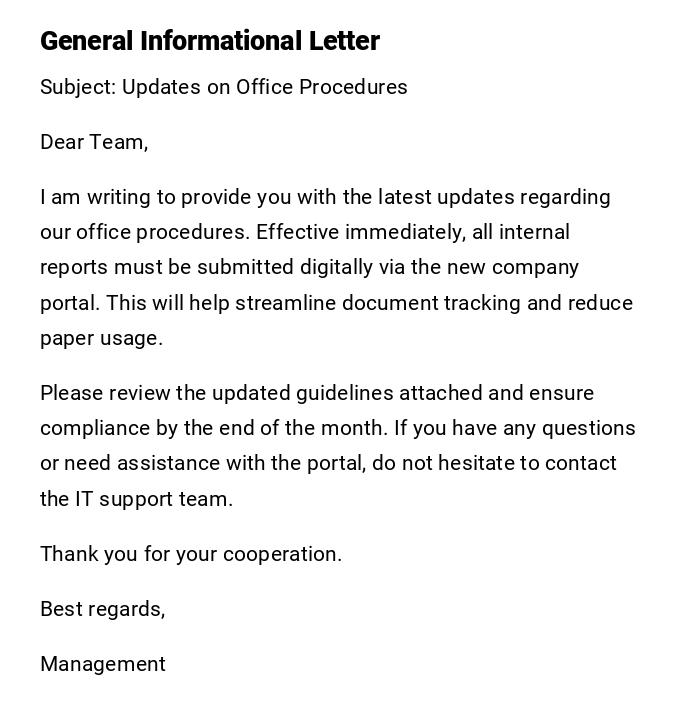
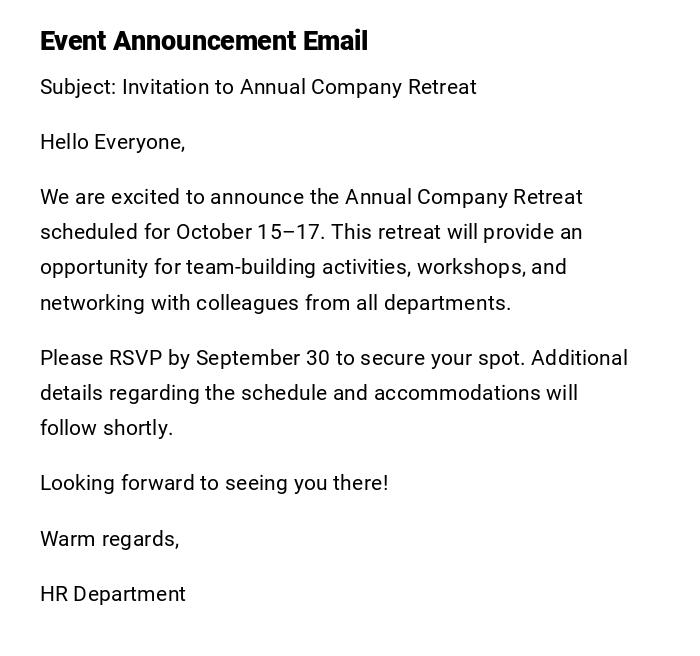
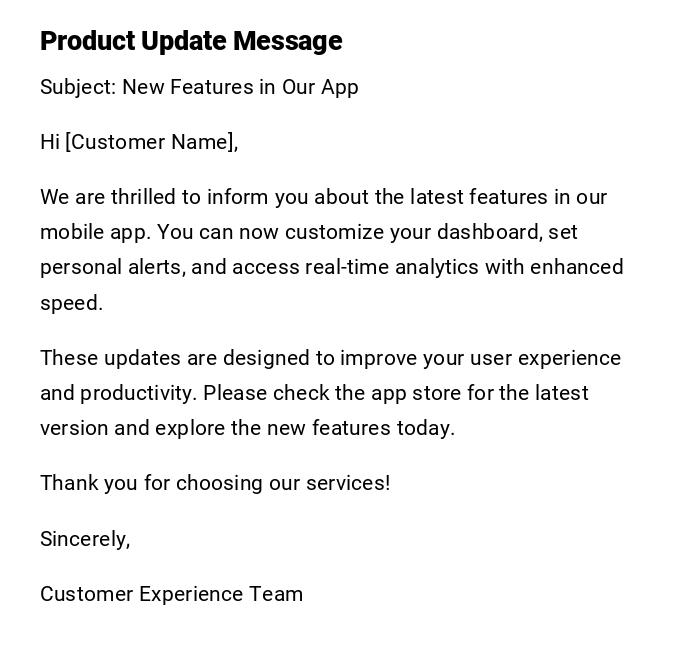
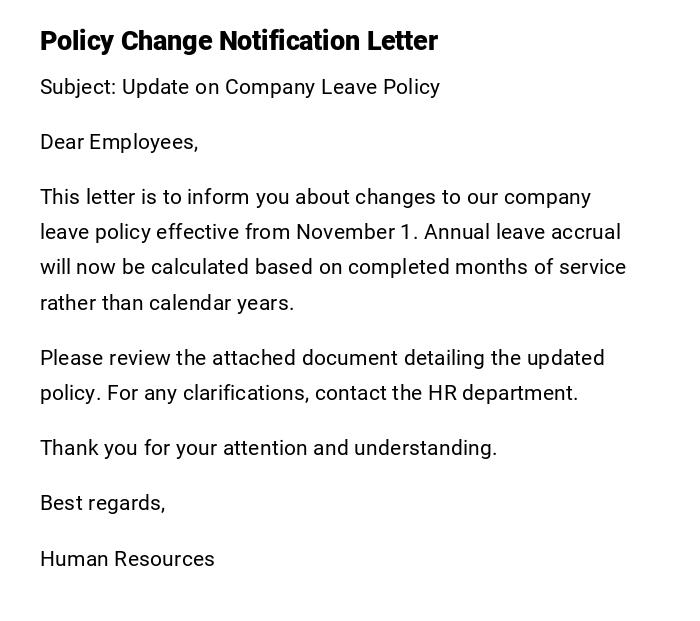
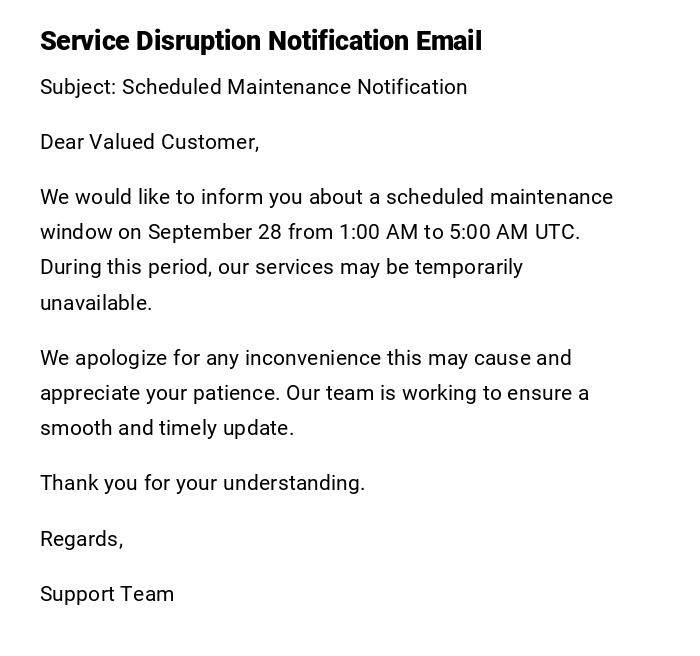

 Download Word Doc
Download Word Doc
 Download PDF
Download PDF